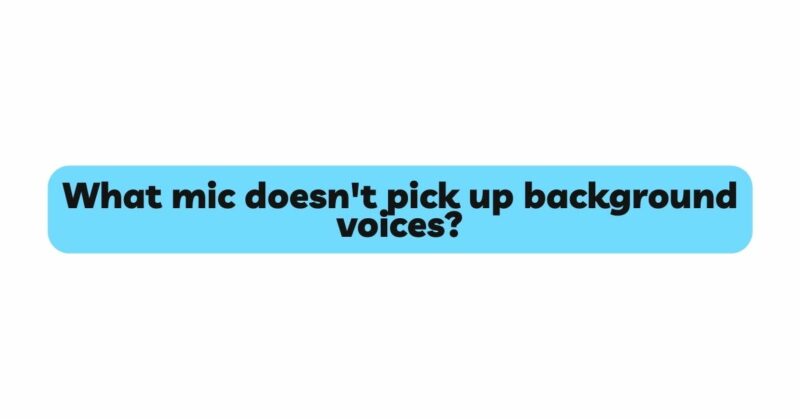In the world of audio technology, achieving pristine sound quality is essential for effective communication, content creation, and various recording purposes. One of the challenges often encountered is finding a microphone that excels at rejecting background voices and noise. Unwanted ambient sounds can compromise the clarity and focus of your recordings, making it crucial to choose a microphone that minimizes the capture of background voices. In this article, we will explore the key factors that contribute to a microphone’s ability to reject background voices, analyze various microphone types and technologies, and provide recommendations for microphones that stand out in their ability to deliver crystal-clear capture in noisy environments.
I. Understanding Background Voice Rejection
- Microphone Polar Patterns: Microphone polar patterns play a central role in determining how a microphone captures sound. Different patterns have varying sensitivity to sound from different directions, influencing the microphone’s ability to reject background voices.
- Background Noise: Background voices often come from different sources and angles, making it essential to choose a microphone with a polar pattern that effectively reduces the pickup of sounds not originating directly in front of the microphone.
II. Cardioid and Supercardioid Microphones
- Cardioid Pattern: Cardioid microphones are designed to capture sound primarily from the front while rejecting sound from the sides and rear. This pattern is highly effective in reducing background noise, making it a popular choice for various recording scenarios.
- Supercardioid and Hypercardioid Patterns: Supercardioid and hypercardioid microphones offer even narrower sensitivity patterns, focusing on sound from the front and rejecting sound from the sides and rear to a greater extent. These patterns are ideal for capturing a single source while minimizing background voices.
III. Shotgun Microphones
- Highly Directional Capture: Shotgun microphones are known for their extreme directionality. They are designed to pick up sound from a very narrow angle while rejecting sound from the sides and rear. This makes them an excellent choice for rejecting background voices in noisy environments.
- Long Shotgun vs. Short Shotgun: Long shotgun microphones offer even more precise directional capture compared to short shotgun microphones, making them suitable for situations where background noise rejection is paramount.
IV. Dynamic vs. Condenser Microphones
- Dynamic Microphones: Dynamic microphones are inherently less sensitive than condenser microphones. They are often used in live sound settings where background noise rejection is essential.
- Condenser Microphones: While condenser microphones are more sensitive, they can still excel at rejecting background voices when equipped with the right polar pattern and noise rejection technology.
V. Advanced Noise-Cancellation Technologies
- Active Noise Cancellation: Some microphones are equipped with active noise cancellation technology that actively analyzes and cancels out background noise, resulting in a cleaner audio signal.
- Digital Signal Processing (DSP): Microphones with advanced DSP algorithms can intelligently filter out unwanted background noise, preserving the clarity of the main audio source.
VI. Recommendations: Microphones That Reject Background Voices
- Shure SM7B: The Shure SM7B is a dynamic microphone with a cardioid pattern, making it excellent for rejecting background noise. It’s a popular choice for broadcasting and podcasting.
- Audio-Technica AT4053B: The Audio-Technica AT4053B is a hypercardioid shotgun microphone with exceptional background noise rejection, ideal for field recording and interviews.
- Sennheiser MKH 416: The Sennheiser MKH 416 is a highly regarded shotgun microphone with a supercardioid pattern, favored by professionals for its exceptional rejection of background voices.
VII. Environment and Mic Placement
- Optimal Mic Placement: Proper microphone placement is essential for maximizing background noise rejection. Position the microphone close to the sound source while minimizing its exposure to other noise sources.
- Controlled Recording Environment: Creating a controlled recording environment with acoustic treatment and noise isolation measures can significantly enhance a microphone’s ability to reject background voices.
VIII. Conclusion: Capturing Clarity in a Noisy World
Choosing a microphone that excels at rejecting background voices is essential for achieving crystal-clear audio in various scenarios. The right polar pattern, microphone type, and technology can help ensure that your recordings remain focused on the intended source while minimizing the impact of unwanted ambient noise. By understanding the features that contribute to background noise rejection and selecting the appropriate microphone for your needs, you can elevate the quality of your recordings, presentations, and communication to new heights.


